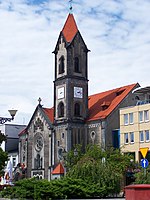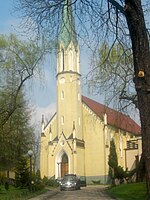Uniate Evangelical Church in Polish Upper Silesia
The Uniate Evangelical Church in Polish Upper Silesia ( Polish Ewangelicki Kościół Unijny na polskim Górnym Śląsku ) was a Uniate Evangelical Church during the Second Polish Republic .
history
The church existed between 1923 and 1939 in East Upper Silesia , the northern and central part of the autonomous Silesian Voivodeship . When East Upper Silesia was ceded to Poland in 1922 , the 17 Protestant parishes there, the entire parish of Pleß and seven parishes of the parish of Gleiwitz with a total of 24 clergymen, withdrew from the church province of Silesia from the Evangelical Church of the older provinces of Prussia (Old Prussian Union) and trained on it Synod in Pless on June 6, 1923 the Uniate Evangelical Church in Polish Upper Silesia with its seat in Katowice . This Polish regional church remained spiritually and financially dependent on the ecclesiastical province of Silesia. "This was expressly granted in § 95 and § 96 of the German-Polish Geneva Agreement on Upper Silesia of May 15, 1922." The Polish authorities did not allow other Protestant churches in Poland to cooperate across borders with German regional churches.
A connection with the Uniate Evangelical Church in Poland and an affiliation of German-speaking Evangelical parishes in the former Austrian Silesia ( Bielitz , Old Bielitz and Upper Kurzwald ) were considered. In 1922 they separated from the Evangelical Church of the Augsburg and Helvetic Confessions in Lesser Poland .
The majority of the church members in the cities were members of the German minority ; the parishes in southern East Upper Silesia were Polish-speaking. Later, Polish-speaking Lutherans from Cieszyn Silesia joined them. Almost all parishes were Lutheran , only Hołdunów was reformed . Protestants were in the minority in almost the entire area. In 1924 there were about 40,000 members. By 1936 their number had decreased to below 30,000. The highest proportions of Protestants in 1933 were in the municipalities of Golasowice (75.3%), Gać (71.6%), Hołdunów (70.6%), Bzie Dolne (60.6%), Cisówka (34, 4%), Marusze (30.4%) and Ruptawa (29.7%).
The Protestant Władysław Michejda (1896–1943) from the western Olsa region that came to Czechoslovakia (part of Cieszyn Silesia until 1918), where he had led the national struggle for the Polish cause, turned after an interlude with the Polish military at the end of the 1920s Struggle for Polish nationality in the Uniate Evangelical Church in Polish Upper Silesia. He led disputes between Polish-speaking church members against the church leadership, which was mostly composed of German-speaking people, for the purpose of clarification before ordinary courts.
In court, for example, he obtained the annulment of the synodal resolution that barred immigrant, mostly Polish-speaking Protestants from parts of Poland, which formerly belonged to Russia and Austria, to the church in Polish Upper Silesia. Michejda represented his positions in the magazine Ewangelik Górnośląski , which he founded and which appeared from 1932 to 1939. Through the Upper Silesian Mixed Commission, an organ for the settlement of disputes established by the German-Polish Geneva Agreement, he obtained the approval of the Polish language in Protestant religious instruction.
With the expiry of the Geneva Agreement in May 1937, protection against encroachments on church autonomy ceased and the church in Polish Upper Silesia lost its status as an old Prussian church province. Michejda won the Silesian Parliament over in July of that year to enact a draft of a new church ordinance for the church in Polish Upper Silesia, which he had drafted, whereby he temporarily took over the church leadership and sent Polish-speaking pastors to the parishes.
Church president Hermann Voss , in office from 1923 to 1937, was deposed by the Silesian Sejm law. The church organs did not recognize the removal. After the death of Voss in 1938, the other members of the church leadership elected Oskar Wagner as church president, but the Polish government soon expelled him to Germany.
From September 1938 to April 1939 Michejda worked in the fight for the connection of the Czechoslovak western Olsa region to Poland, whereupon in May 1939, after Poland had annexed its Polish-speaking Olsa region in anticipation of the decision in Munich to split up Czechoslovakia along language lines at the end of October 1938, moved to Těšín , where he became trustee of the expropriated Trzynietz ironworks for the Polish government .
After the attack on Poland , autonomous Silesia was occupied by the Wehrmacht and German Upper Silesia was annexed. The Uniate Evangelical Church in Polish Upper Silesia was dissolved and from November 1939 to 1945 its parishes belonged to the Evangelical Church of the Old Prussian Union, as the Old Prussian Church was called since 1922. With the flight of many Protestants from Upper Silesia and the expulsion of many by the Polish post-war regime, their number fell and the church was not re-established. The remaining Protestants and their parishes belonged to the Evangelical-Augsburg Church in Poland after 1945 .
Communities
| local community | founding year | Number of members (1937) | church | image |
|---|---|---|---|---|
| Pszczyna (Pless) | 1742 (1764) | 3150 | Evangelical Church in Pszczyna |

|
| Tarnowskie Góry (Tarnowitz) | 1742 (1764) | 1023 | Evangelical Church in Tarnowskie Góry |

|
| Piasek (Ludwigsthal) | 1754 (1764) | 190 | Evangelical Church in Piasek |

|
| Golasowice (Gollasowitz) | 1765 | 1985 | Evangelical Church in Golasowice |

|
| Wodzisław Śląski (Loslau) | 1776 (in Marusze ) | 615 | Evangelical Church in Wodzisław Śląski |

|
| Hołdunów (Anhalt OS) | 1770 | 798 | Evangelical Church in Hołdunów (destroyed) |

|
| Rybnik | around 1791 | 1110 | Evangelical Church in Rybnik |

|
| Lubliniec (Lublinitz) | around 1850 | 160 | Evangelical Church in Lubliniec |

|
| Żory (Sohrau) | 1851 | 985 | Evangelical Church in Żory |

|
| Mikołów (Nikolai) | 1854 | 2030 | Evangelical Church in Mikołów |

|
| Katowice (Katowice) | 1856 | 7100 | Church of the Resurrection (Katowice) |

|
| Mysłowice (Myslowitz) | 1857 | 1550 | Evangelical Church in Mysłowice |

|
| Królewska Huta (from 1934 Chorzów) (Königshütte) | around 1876 | 5015 | Evangelical Church in Chorzów |

|
| Siemianowice (Siemianowitz) | 1888 | 2510 | Evangelical Church in Siemianowice |

|
| Nowa Wieś (today Wirek) (Antonienhütte) | 1898 | 1215 | Evangelical Church in Ruda Śląska |

|
| Ruptawa (Ruptau) | 1908 | 996 | Old Evangelical Church in Jastrzębie-Zdrój |

|
| Szopienice (Rozdzień) (Schoppinitz) | 1910 (Rozdzień) | 1250 | Evangelical Church in Katowice-Szopienice |

|
| Świętochłowice (Schwientochlowitz) | 1910 | 2020 | Evangelical Church in Świętochłowice |

|
| Lipiny (lipine) | 915 | Evangelical Church in Lipiny (destroyed) | on a postcard (1918) | |
| Warszowice (Warschowitz) | around 1933 | 498 | Old Evangelical Church in Warszowice | on a photo |
literature
- Henryk Czembor: Ewangelicki Kościół Unijny na polskim Górnym Śląsku . Dom Wydawniczy i Księgarski “Didache”, Katowice 1993, OCLC 80237547 (Polish).
- Stefan Grelewski: Wyznania protestanckie i sekty religijne w Polsce współczesnej . Lublin 1937, p. 333-341 (Polish, online ).
Web links
- History of the parish in Katowice (Polish)
Individual evidence
- ↑ The also previously associated with the Silesian Church Province of Protestant churches in 1920 ceded to Czechoslovakia Hultschin came to the Silesian Evangelical Church , the Lower Silesian parishes in ceded to Poland Bralin and Triebusch to the Uniate Evangelical Church in Poland.
- ^ Alfred Kleindienst , Oskar Wagner : Protestantism in the Republic of Poland 1918/19 to 1939 in the field of tension between nationality politics and state church law, church and national contrasts (= Marburg East Research; Vol. 42). J.-G.-Herder-Institut, Marburg an der Lahn 1985, ISBN 3-87969-179-7 , p. 436ff.
- ↑ See “German-Polish Agreement on Upper Silesia” (Upper Silesia Agreement, OSA) of May 15, 1922, in: Reichsgesetzblatt , 1922, Part II, p. 238ff.
- ↑ Source book on the history of the Evangelical Church in Silesia (= writings of the Federal Institute for East German Culture and History, Vol. 1). Edited by Gustav Adolf Benrath on behalf of the Federal Institute for East German Culture and History. Oldenbourg, Munich 1992, ISBN 3-486-55916-8 , p. 382.
- ↑ H. Czembor, 1993, p. 41
- ↑ H. Czembor, 1993, p. 39
- ↑ H. Czembor, 1993, p. 46
- ↑ H. Czembor, 1993, p. 45
- ^ Wilhelm Hüffmeier : The Evangelical Church of the Union. A brief historical orientation. In: "... according to the great purposes of Christianity" - The Evangelical Church of the Union 1817 to 1992. A handout for the communities. Edited by Wilhelm Hüffmeier, published by the church chancellery of the Evangelical Church of the Union. Luther-Verlag, Bielefeld 1992, ISBN 3-7858-0346-X , pp. 13–28, here p. 22.
- ^ Barbara Michejda-Pinno: Dr Władysław Michejda z Katowic. Jego walka o prawa Polaków pomiędzy dwoma wojnami o niepodległość Polski. In: Weronika Nagengast, Jan Szturc (ed.): O polski Śląsk: Tadeusz Michejda (1895–1955), Władysław Michejda (1896–1943) (= Studia z Dziejów Ewangelicyzmu na Górnym Śląsku, vol. 1). Muzeum Śląskie, Kattowitz 2000, ISBN 8-387-45595-4 , pp. 75-104.
- ^ History of the parish in Katowice
- ↑ Handbook of the German Protestant Churches 1918 to 1949: Organs - Offices - Associations - People (= work on contemporary church history, series A, sources, vol. 20). Edited by Heinz Boberach, Carsten Nicolaisen and Ruth Pabst. Vandenhoeck & Ruprecht, Göttingen 2010, Vol. 2 Landes- und Provinzialkirchen , p. 411.
- ↑ Handbook of the German Protestant Churches 1918 to 1949: Organs - Offices - Associations - People (= work on contemporary church history, series A, sources, vol. 20). Edited by Heinz Boberach, Carsten Nicolaisen and Ruth Pabst. Vandenhoeck & Ruprecht, Göttingen 2010, Vol. 2 Landes- und Provinzialkirchen , p. 410.
- ↑ Stefan Grelewski: wyznania protestanckie i sekty religijne w Polsce współczesnej . Lublin 1937, p. 341 (Polish, online ).
- ↑ Historia parafii w Rybniku ( Memento of the original from March 16, 2014 in the Internet Archive ) Info: The archive link was inserted automatically and has not yet been checked. Please check the original and archive link according to the instructions and then remove this notice.
- ↑ Historia zboru ewangelickiego w Lublińcu
- ↑ Historia parafii w Chorzowie ( Memento of the original dated November 8, 2014 in the Internet Archive ) Info: The archive link was inserted automatically and has not yet been checked. Please check the original and archive link according to the instructions and then remove this notice.